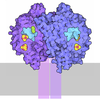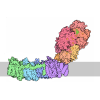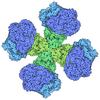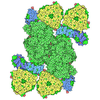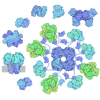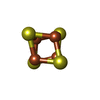[English] 日本語
 Yorodumi
Yorodumi- PDB-9c0q: Carbon monoxide dehydrogenase (CODH) from Methanosarcina thermoph... -
+ Open data
Open data
- Basic information
Basic information
| Entry | Database: PDB / ID: 9c0q | |||||||||
|---|---|---|---|---|---|---|---|---|---|---|
| Title | Carbon monoxide dehydrogenase (CODH) from Methanosarcina thermophila, specimen prepared on blot plunger | |||||||||
 Components Components |
| |||||||||
 Keywords Keywords | OXIDOREDUCTASE / CO-dehydrogenase | |||||||||
| Function / homology |  Function and homology information Function and homology informationmethanogenesis, from acetate / anaerobic carbon monoxide dehydrogenase / hydroxylamine reductase activity / anaerobic carbon-monoxide dehydrogenase activity / acetyl-CoA metabolic process / nickel cation binding / peroxidase activity / response to hydrogen peroxide / 4 iron, 4 sulfur cluster binding / iron ion binding Similarity search - Function | |||||||||
| Biological species |   Methanosarcina thermophila (archaea) Methanosarcina thermophila (archaea) | |||||||||
| Method | ELECTRON MICROSCOPY / single particle reconstruction / cryo EM / Resolution: 3.3 Å | |||||||||
 Authors Authors | Biester, A. / Drennan, C.L. | |||||||||
| Funding support |  United States, 2items United States, 2items
| |||||||||
 Citation Citation |  Journal: Proc Natl Acad Sci U S A / Year: 2024 Journal: Proc Natl Acad Sci U S A / Year: 2024Title: Capturing a methanogenic carbon monoxide dehydrogenase/acetyl-CoA synthase complex via cryogenic electron microscopy. Authors: Alison Biester / David A Grahame / Catherine L Drennan /  Abstract: Approximately two-thirds of the estimated one-billion metric tons of methane produced annually by methanogens is derived from the cleavage of acetate. Acetate is broken down by a Ni-Fe-S-containing A- ...Approximately two-thirds of the estimated one-billion metric tons of methane produced annually by methanogens is derived from the cleavage of acetate. Acetate is broken down by a Ni-Fe-S-containing A-cluster within the enzyme acetyl-CoA synthase (ACS) to carbon monoxide (CO) and a methyl group (CH). The methyl group ultimately forms the greenhouse gas methane, whereas CO is converted to the greenhouse gas carbon dioxide (CO) by a Ni-Fe-S-containing C-cluster within the enzyme carbon monoxide dehydrogenase (CODH). Although structures have been solved of CODH/ACS from acetogens, which use these enzymes to make acetate from CO, no structure of a CODH/ACS from a methanogen has been reported. In this work, we use cryo-electron microscopy to reveal the structure of a methanogenic CODH and CODH/ACS from (CODH/ACS). We find that the N-terminal domain of acetogenic ACS, which is missing in all methanogens, is replaced by a domain of CODH. This CODH domain provides a channel for CO to travel between the two catalytic Ni-Fe-S clusters. It generates the binding surface for ACS and creates a remarkably similar CO alcove above the A-cluster using residues from CODH rather than ACS. Comparison of our CODH/ACS structure with our CODH structure reveals a molecular mechanism to restrict gas flow from the CO channel when ACS departs, preventing CO escape into the cell. Overall, these long-awaited structures of a methanogenic CODH/ACS reveal striking functional similarities to their acetogenic counterparts despite a substantial difference in domain organization. | |||||||||
| History |
|
- Structure visualization
Structure visualization
| Structure viewer | Molecule:  Molmil Molmil Jmol/JSmol Jmol/JSmol |
|---|
- Downloads & links
Downloads & links
- Download
Download
| PDBx/mmCIF format |  9c0q.cif.gz 9c0q.cif.gz | 356 KB | Display |  PDBx/mmCIF format PDBx/mmCIF format |
|---|---|---|---|---|
| PDB format |  pdb9c0q.ent.gz pdb9c0q.ent.gz | 288.3 KB | Display |  PDB format PDB format |
| PDBx/mmJSON format |  9c0q.json.gz 9c0q.json.gz | Tree view |  PDBx/mmJSON format PDBx/mmJSON format | |
| Others |  Other downloads Other downloads |
-Validation report
| Summary document |  9c0q_validation.pdf.gz 9c0q_validation.pdf.gz | 1.3 MB | Display |  wwPDB validaton report wwPDB validaton report |
|---|---|---|---|---|
| Full document |  9c0q_full_validation.pdf.gz 9c0q_full_validation.pdf.gz | 1.3 MB | Display | |
| Data in XML |  9c0q_validation.xml.gz 9c0q_validation.xml.gz | 60.3 KB | Display | |
| Data in CIF |  9c0q_validation.cif.gz 9c0q_validation.cif.gz | 90.6 KB | Display | |
| Arichive directory |  https://data.pdbj.org/pub/pdb/validation_reports/c0/9c0q https://data.pdbj.org/pub/pdb/validation_reports/c0/9c0q ftp://data.pdbj.org/pub/pdb/validation_reports/c0/9c0q ftp://data.pdbj.org/pub/pdb/validation_reports/c0/9c0q | HTTPS FTP |
-Related structure data
| Related structure data |  45089MC  9c0rC  9c0sC  9c0tC M: map data used to model this data C: citing same article ( |
|---|---|
| Similar structure data | Similarity search - Function & homology  F&H Search F&H Search |
| Experimental dataset #1 | Data reference:  10.6019/EMPIAR-12108 / Data set type: EMPIAR / Metadata reference: 10.6019/EMPIAR-12108 10.6019/EMPIAR-12108 / Data set type: EMPIAR / Metadata reference: 10.6019/EMPIAR-12108 |
- Links
Links
- Assembly
Assembly
| Deposited unit | 
|
|---|---|
| 1 |
|
- Components
Components
| #1: Protein | Mass: 87855.852 Da / Num. of mol.: 2 / Source method: isolated from a natural source / Source: (natural)   Methanosarcina thermophila (archaea) Methanosarcina thermophila (archaea)References: UniProt: Q9C4Z4, anaerobic carbon monoxide dehydrogenase #2: Protein | Mass: 18587.375 Da / Num. of mol.: 2 / Source method: isolated from a natural source / Source: (natural)   Methanosarcina thermophila (archaea) / References: UniProt: Q9C4Z3 Methanosarcina thermophila (archaea) / References: UniProt: Q9C4Z3#3: Chemical | ChemComp-SF4 / #4: Chemical | Has ligand of interest | Y | Has protein modification | N | |
|---|
-Experimental details
-Experiment
| Experiment | Method: ELECTRON MICROSCOPY |
|---|---|
| EM experiment | Aggregation state: PARTICLE / 3D reconstruction method: single particle reconstruction |
- Sample preparation
Sample preparation
| Component | Name: Acetyl-CoA decarbonylase/synthase complex / Type: COMPLEX Details: Carbon monoxide dehydrogenase heterotetramer, alpha and epsilon subunits Entity ID: #1-#2 / Source: NATURAL | |||||||||||||||
|---|---|---|---|---|---|---|---|---|---|---|---|---|---|---|---|---|
| Molecular weight | Value: 0.212 MDa / Experimental value: NO | |||||||||||||||
| Source (natural) | Organism:   Methanosarcina thermophila (archaea) Methanosarcina thermophila (archaea) | |||||||||||||||
| Buffer solution | pH: 7.2 | |||||||||||||||
| Buffer component |
| |||||||||||||||
| Specimen | Conc.: 1 mg/ml / Embedding applied: NO / Shadowing applied: NO / Staining applied: NO / Vitrification applied: YES | |||||||||||||||
| Specimen support | Grid material: COPPER / Grid mesh size: 300 divisions/in. / Grid type: Quantifoil R1.2/1.3 | |||||||||||||||
| Vitrification | Instrument: GATAN CRYOPLUNGE 3 / Cryogen name: ETHANE / Humidity: 80 % / Chamber temperature: 298 K |
- Electron microscopy imaging
Electron microscopy imaging
| Experimental equipment |  Model: Titan Krios / Image courtesy: FEI Company |
|---|---|
| Microscopy | Model: FEI TITAN KRIOS |
| Electron gun | Electron source:  FIELD EMISSION GUN / Accelerating voltage: 300 kV / Illumination mode: FLOOD BEAM FIELD EMISSION GUN / Accelerating voltage: 300 kV / Illumination mode: FLOOD BEAM |
| Electron lens | Mode: BRIGHT FIELD / Nominal magnification: 105000 X / Nominal defocus max: 2100 nm / Nominal defocus min: 800 nm / Cs: 2.7 mm / C2 aperture diameter: 50 µm |
| Image recording | Electron dose: 54.53 e/Å2 / Film or detector model: GATAN K3 BIOQUANTUM (6k x 4k) |
- Processing
Processing
| EM software |
| ||||||||||||||||||||||||||||||||||||||||||||
|---|---|---|---|---|---|---|---|---|---|---|---|---|---|---|---|---|---|---|---|---|---|---|---|---|---|---|---|---|---|---|---|---|---|---|---|---|---|---|---|---|---|---|---|---|---|
| CTF correction | Type: PHASE FLIPPING AND AMPLITUDE CORRECTION | ||||||||||||||||||||||||||||||||||||||||||||
| Particle selection | Num. of particles selected: 852015 | ||||||||||||||||||||||||||||||||||||||||||||
| Symmetry | Point symmetry: C2 (2 fold cyclic) | ||||||||||||||||||||||||||||||||||||||||||||
| 3D reconstruction | Resolution: 3.3 Å / Resolution method: FSC 0.143 CUT-OFF / Num. of particles: 99894 / Num. of class averages: 1 / Symmetry type: POINT | ||||||||||||||||||||||||||||||||||||||||||||
| Atomic model building | B value: 90.5204 / Space: REAL / Target criteria: Correlation coefficient Details: Initial model was generated using AlphaFold, fit to the map using ChimeraX, followed by rigid body fitting in phenix, and finally iterative real space refinement in coot and phenix. | ||||||||||||||||||||||||||||||||||||||||||||
| Atomic model building | Source name: AlphaFold / Type: in silico model | ||||||||||||||||||||||||||||||||||||||||||||
| Refine LS restraints |
|
 Movie
Movie Controller
Controller





 PDBj
PDBj